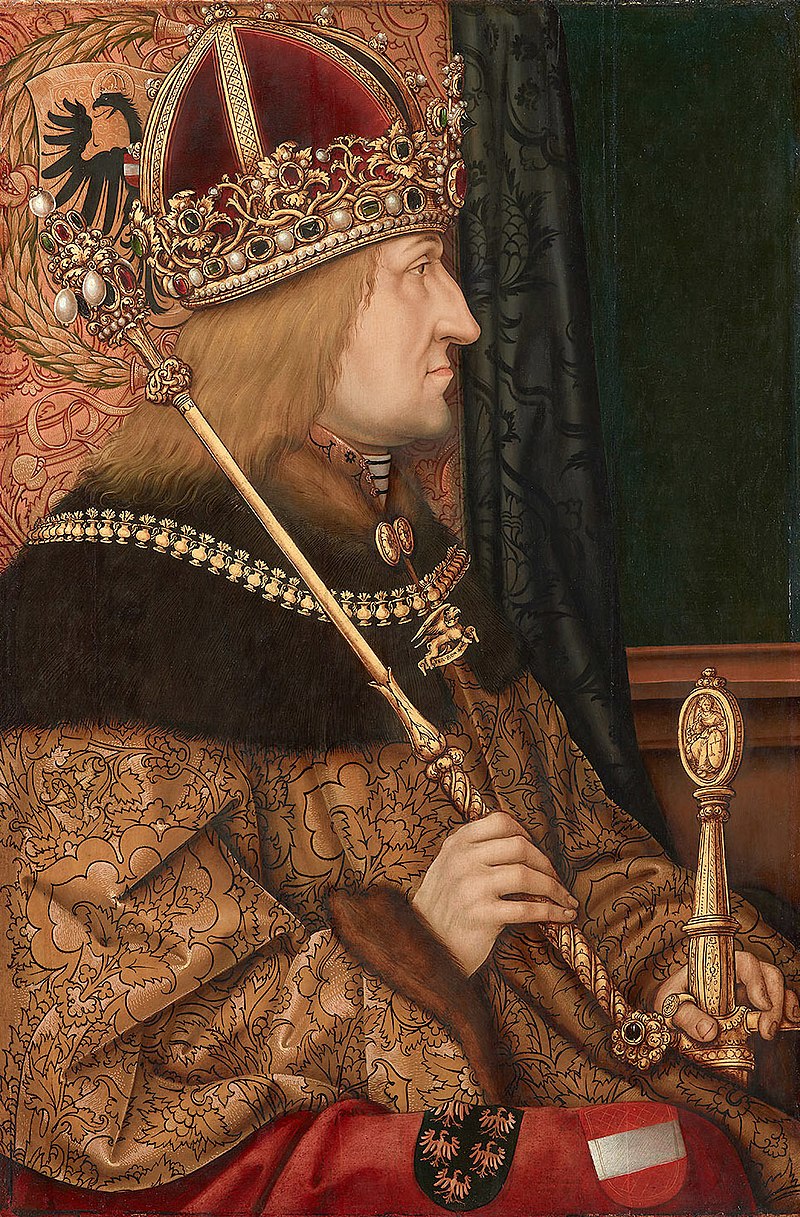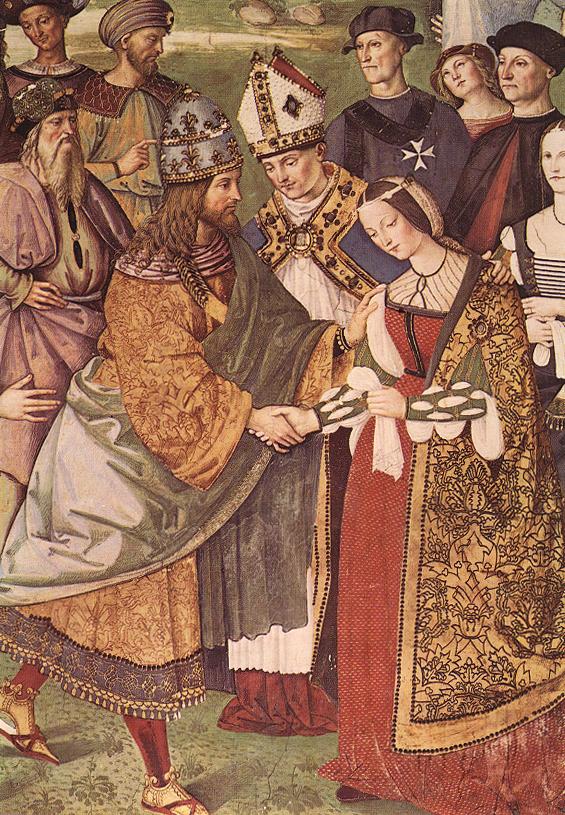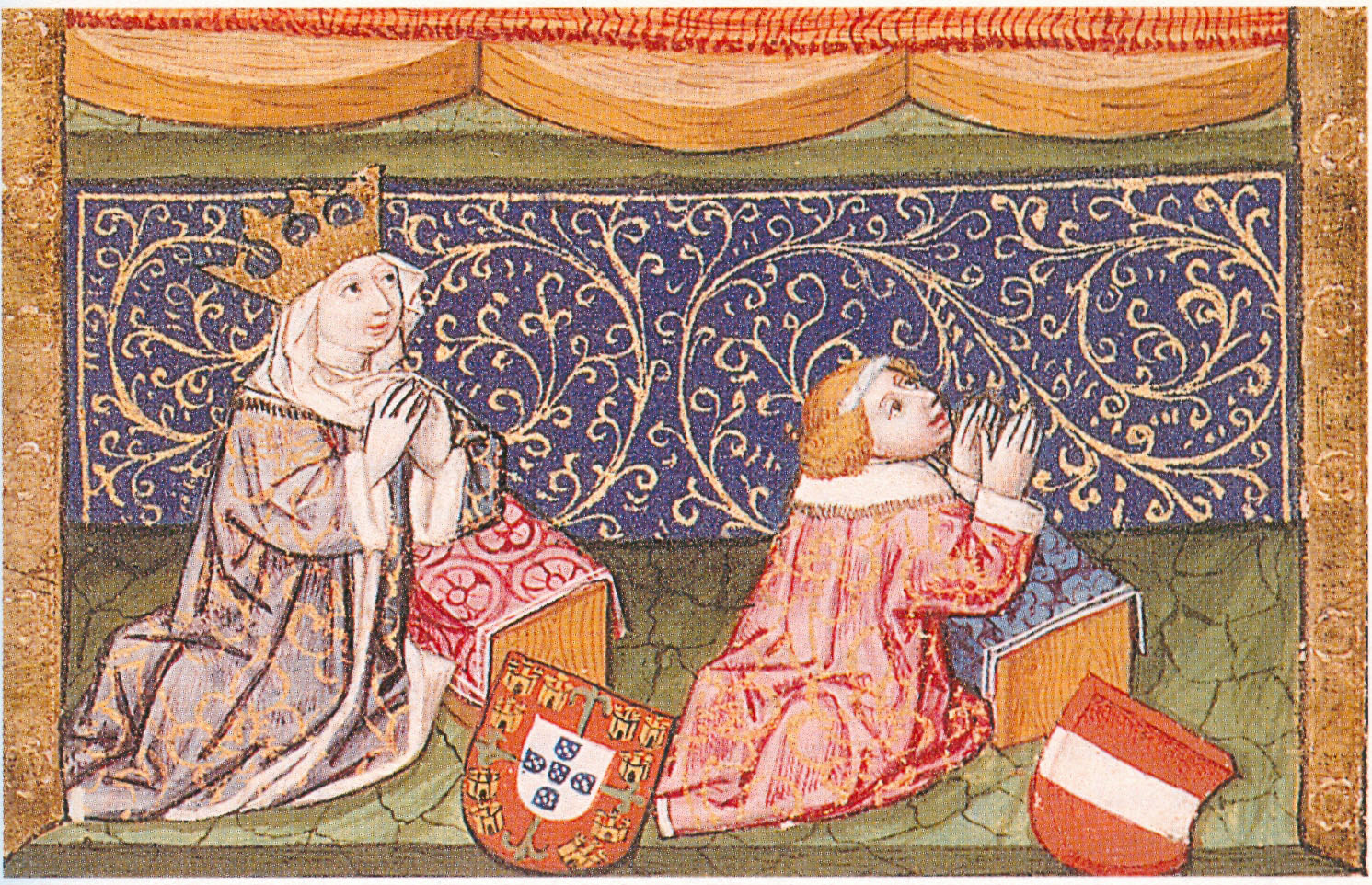by Susan Flantzer
© Unofficial Royalty 2023

Friedrich III, Holy Roman Emperor; Credit – Wikipedia
The Holy Roman Empire was a limited elective monarchy composed of hundreds of kingdoms, principalities, duchies, counties, prince-bishoprics, and Free Imperial Cities in central Europe. The Holy Roman Empire was not really holy since, after Holy Roman Emperor Charles V in 1530, no emperors were crowned by the pope or a bishop. It was not Roman but rather German because it was mainly in the regions of present-day Germany and Austria. It was an empire in name only – the territories it covered were mostly independent each with its own rulers. The Holy Roman Emperor directly ruled over only his family territories, and could not issue decrees and rule autonomously over the Holy Roman Empire. A Holy Roman Emperor was only as strong as his army and alliances, including marriage alliances, made him, and his power was severely restricted by the many sovereigns of the constituent monarchies of the Holy Roman Empire. From the 13th century, prince-electors, or electors for short, elected the Holy Roman Emperor from among the sovereigns of the constituent states.
Frequently but not always, it was common practice to elect the deceased Holy Roman Emperor’s heir. The Holy Roman Empire was an elective monarchy. No person had a legal right to the succession simply because he was related to the current Holy Roman Emperor. However, the Holy Roman Emperor could and often did, while still alive, have a relative (usually a son) elected to succeed him after his death. This elected heir apparent used the title King of the Romans.
Learn more at Unofficial Royalty: What was the Holy Roman Empire?
********************
Friedrich III reigned as Holy Roman Emperor effectively from 1440 to 1493, as Friedrich V, Duke of Styria, Carinthia, and Carniola from 1424 to 1493, and as Friedrich V, Duke (Duchy of Austria) and then Archduke of Austria (Archduchy of Austria) from 1457 to 1493. He would lay the foundation that would keep the House of Habsburg in a power play position until its fall after World War I. Friedrich was born on September 21, 1415, in Innsbruck, County of Tyrol, now in Austria. He was the eldest of the nine children and the eldest of the six sons of Ernst II, Duke of Styria, Carinthia and Carniola, the Inner Austrian duchies, and his second wife Cymburgis of Masovia, a member of the Polish Piast dynasty. Friedrich’s paternal grandparents were Leopold III, Duke of Austria and Viridis Visconti, a member of the House of Visconti which ruled in Milan, now in Italy. His maternal grandparents were Siemowit IV, Duke of Masovia and Alexandra of Lithuania.
Friedrich had eight siblings but only three survived infancy:
- Margaretha of Austria (1416 – 1486), married Friedrich II, Elector of Saxony, had eight children
- Albrecht VI, Archduke of Austria (1418 – 1463), married Mechthild of the Palatinate, no children
- Katherina of Austria (1420 – 1493), married Karl I, Margrave of Baden-Baden, had six children
- Ernst of Austria (1420 – 1432), died in childhood
- Alexander of Austria (born and died 1421)
- Anna of Austria (1422 – 1429), died in childhood
- Leopold of Austria (1423 – 1424), died in infancy
- Rudolph of Austria (born and died 1424), died in infancy
In 1424, when Friedrich was nine years old, his father Ernst II died and Friedrich became the Duke of Styria, Carinthia, and Carniola. Although the young duke lived with his mother in Graz or in Wiener Neustadt, both in Duchy of Styria, now in Austria, Friedrich’s paternal uncle Friedrich IV, Duke of Austria, Count of Tyrol became the guardian of Friedrich and his brother Albrecht and the Regent of the Duchies of Styria, Carinthia, and Carniola. Friedrich’s uncle ensured that his nephews received a good education. In 1429, when he was fourteen years old Friedrich’s mother Cymburgis of Masovia died.
In 1435, Friedrich was deemed old enough to rule over his duchies although his younger brother Albrecht tried to assert himself as co-ruler, the beginning of a long rivalry. In 1436, Friedrich made a pilgrimage to the Holy Land and was knighted by the Order of the Holy Sepulchre which greatly increased his status. When his uncle Friedrich IV, Duke of Austria, Count of Tyrol died in 1439, Friedrich served as Regent for his twelve-year-old first cousin Sigismund until 1446.
Friedrich also served as Regent of Austria for Ladislaus the Posthumous, Duke of Austria. As his name indicates, Ladislaus was born four months after the death in 1439 of his father Albrecht V, Duke of Austria. In 1438, Albrecht V had been elected King of the Romans, a title used after the election but before the coronation of the Holy Roman Emperor. Albert was effectively the Holy Roman Emperor, however, due to his death, he was never crowned Holy Roman Emperor and could not use the title. When Ladislaus died at the age of seventeen, unmarried, his branch of the House of Habsburg became extinct, and Friedrich became Duke of Austria. Friedrich was now the ruler of all the sovereign Austrian states and was the undisputed head of the House of Habsburg. Because of the death in 1439 of Albert V, who would have been Holy Roman Emperor upon his coronation, a successor had to be elected by the prince-electors. On February 2, 1440, 25-year-old Friedrich was unanimously elected King of the Romans and although effectively Holy Roman Emperor, he would not officially become Holy Roman Empire until his coronation by the pope in Rome.
The woman Friedrich would eventually marry was Infanta Eleanor of Portugal, the daughter of King Duarte of Portugal and Eleanor of Aragon. A marriage with Friedrich was probably suggested by her aunt Isabella of Portugal, Duchess of Burgundy. Eleanor was also suggested as a bride for the future King Louis XI of France but Eleanor preferred Friedrich because a marriage with him would make her an empress instead of a queen. Marriage negotiations were conducted by Eleanor’s maternal uncle King Alfonso V of Aragon and Naples.

Friedrich meets Eleanor of Portugal for the first time by Pinturicchio, circa 1502-1507; Credit – Wikipedia
In 1452, 37-year-old Friedrich traveled to Rome to marry 18-year-old Infanta Eleanor of Portugal and be crowned Holy Roman Emperor. On March 16, 1452, Friedrich and Eleanor were married by Pope Nicholas V. Finally, on March 19, 1452, Friedrich and Eleanor were anointed in St. Peter’s Basilica by Cardinal Francesco Condulmer, Vice-Chancellor of the Holy Roman Church, and Friedrich was then crowned with the Imperial Crown by Pope Nicholas V. Friedrich III was the last Holy Roman Emperor to be crowned in Rome.

Empress Eleanor and her son Maximilian from Empress Eleanor’s Book of Hours; Credit – Wikipedia
Friedrich and Eleanor had five children but only two survived childhood:
- Archduke Christoph of Austria (1455 – 1456), died in infancy
- Maximilian I, Holy Roman Emperor (1459 – 1519), married (1) Mary, Duchess of Burgundy (in her own right), had three children including Philip of Austria, Lord of the Netherlands, Duke of Burgundy (2) Anne, Duchess of Brittany (in her own right), no children, marriage annulled (3) Bianca Maria Sforza, no children
- Helene of Austria (1460 – 1462), died in early childhood
- Kunigunde of Austria (1465 – 1520), married Albrecht IV, Duke of Bavaria, had seven children
- Johannes of Austria (1466 – 1467), died in early childhood
During his reign, Friedrich concentrated on re-uniting the Habsburg hereditary lands of Austria. In 1453, Friedrich elevated the Duchy of Austria to an Archduchy and took on the title Archduke of Austria. Mary, Duchess of Burgundy, was, in her own right, the ruler of the Burgundian State which consisted of parts of the present-day Netherlands, Belgium, Luxembourg, France, and Germany. Mary had many suitors and Friedrich had the good fortune that Mary chose his eldest surviving son Maximilian, the future Holy Roman Emperor Maximilian I, as her husband. The couple married in 1477 and Maximilian became her co-ruler. With the inheritance of the Burgundian State, the House of Habsburg began to rise to predominance in Europe. Looking into the future, Maximilian and Mary’s son Philip of Habsburg, also known as Philip the Handsome, was the heir to both his father’s and mother’s dominions. Philip married Juana I, Queen of Castile and León and Queen of Aragon, thereby adding Spain’s dominions to the House of Habsburg. Philip and Juana’s son Charles, best known as Charles V, Holy Roman Emperor, was one of the most powerful ever monarchs and had a large number of titles due to his vast inheritance of the Austrian, Burgundian, and Spanish realms.
Friedrich’s wife Eleanor, aged 32, died on September 3, 1467, from dysentery in Wiener Neustadt, Duchy of Styria, now in Austria. She was buried at the Neukloster Abbey in Wiener Neustadt where her three children who died in childhood were buried. In 1486, Friedrich III, Holy Roman Emperor ensured that his son Maximilian would succeed him as Holy Roman Emperor when the prince-electors unanimously elected Maximilian King of the Romans.

Friedrich III, Holy Roman in old age; Credit – Wikipedia
In February 1493, Friedrich’s health began to worsen. He had an issue with his left leg which contemporary sources referred to as gangrene but in today’s modern medicine, the issue was caused by arteriosclerosis. Friedrich’s doctors decided to amputate the affected leg. Although Friedrich survived the amputation, he died on August 19, 1493, in Linz, Duchy of Austria, now in Austria, at the age of 77. Contemporary sources say the cause of his death was complications from the leg amputation, old age, or dysentery-like diarrhea from eating melon. Friedrich III’s reign of 53 years, from the time he was elected King of the Romans in 1440 until he died in 1493, is the longest reign of a Holy Roman Emperor.

Tomb of Friedrich III, Holy Roman Emperor; Credit – By Uoaei1 – Own work, CC BY-SA 3.0, https://commons.wikimedia.org/w/index.php?curid=24993194
Friedrich III, Holy Roman Emperor, Duke of Styria, Carinthia, and Carniola, Archduke of Austria was initially buried at St. Stephen’s Cathedral in Vienna, Austria, in the Ducal Crypt. In 1463, thirty years before his death, Friedrich commissioned Dutch sculptor Nikolaus Gerhaert van Leyden to build a monumental tomb in St. Stephen’s Cathedral. Van Leyden died in 1473 and the work was completed by Austrian stonemason and sculptor Michael Tichter (link in German). On November 12, 1513, the remains of Friedrich III, Holy Roman Emperor were transferred in a grand ceremony from the Ducal Crypt to the tomb. The tomb lid shows Emperor Friedrich in his coronation regalia surrounded by the coats of arms of all his dominions. The sides of the tomb are decorated with 240 small statues. The tomb is considered a masterpiece of medieval sculptural art.

Depiction of the tomb lid; Credit – Von Georges Jansoone – Selbst fotografiert, CC BY 2.5, https://commons.wikimedia.org/w/index.php?curid=1061466
This article is the intellectual property of Unofficial Royalty and is NOT TO BE COPIED, EDITED, OR POSTED IN ANY FORM ON ANOTHER WEBSITE under any circumstances. It is permissible to use a link that directs to Unofficial Royalty.
Works Cited
- Eleanor of Portugal, Holy Roman Empress (2023) Wikipedia. Wikimedia Foundation. Available at: https://en.wikipedia.org/wiki/Eleanor_of_Portugal,_Holy_Roman_Empress (Accessed: March 2, 2023).
- Ernest, Duke of Austria (2022) Wikipedia. Wikimedia Foundation. Available at: https://en.wikipedia.org/wiki/Ernest,_Duke_of_Austria (Accessed: March 2, 2023).
- Flantzer, Susan. (2022) St. Stephen’s Cathedral in Vienna, Austria, Unofficial Royalty. Available at: https://www.unofficialroyalty.com/st-stephens-cathedral-in-vienna-austria/ (Accessed: March 2, 2023).
- Flantzer, Susan. (2021) What was the Holy Roman Empire?, Unofficial Royalty. Available at: https://www.unofficialroyalty.com/what-was-the-holy-roman-empire/ (Accessed: March 2, 2023).
- Frederick III, Holy Roman Emperor (2023) Wikipedia. Wikimedia Foundation. Available at: https://en.wikipedia.org/wiki/Frederick_III,_Holy_Roman_Emperor (Accessed: March 2, 2023).
- Friedrich III. (HRR) (2023) Wikipedia (German). Wikimedia Foundation. Available at: https://de.wikipedia.org/wiki/Friedrich_III._(HRR) (Accessed: March 2, 2023).
- Wheatcroft, Andrew. (1995) The Habsburgs. London: Viking.
- Wilson, Peter H. (2016) Heart of Europe – A History of the Holy Roman Empire. Cambridge, MA: Harvard University Press.
